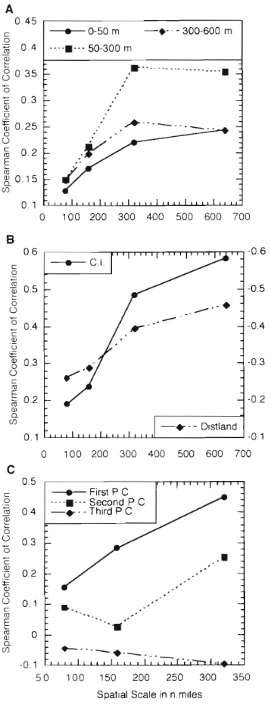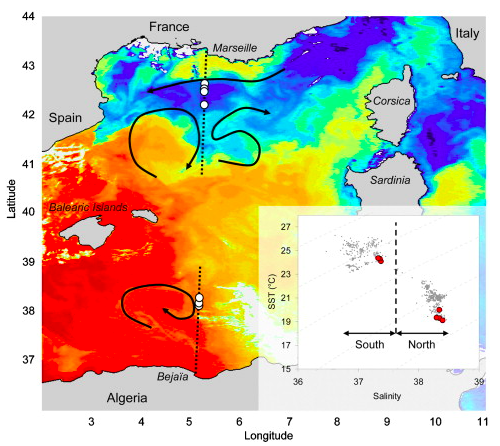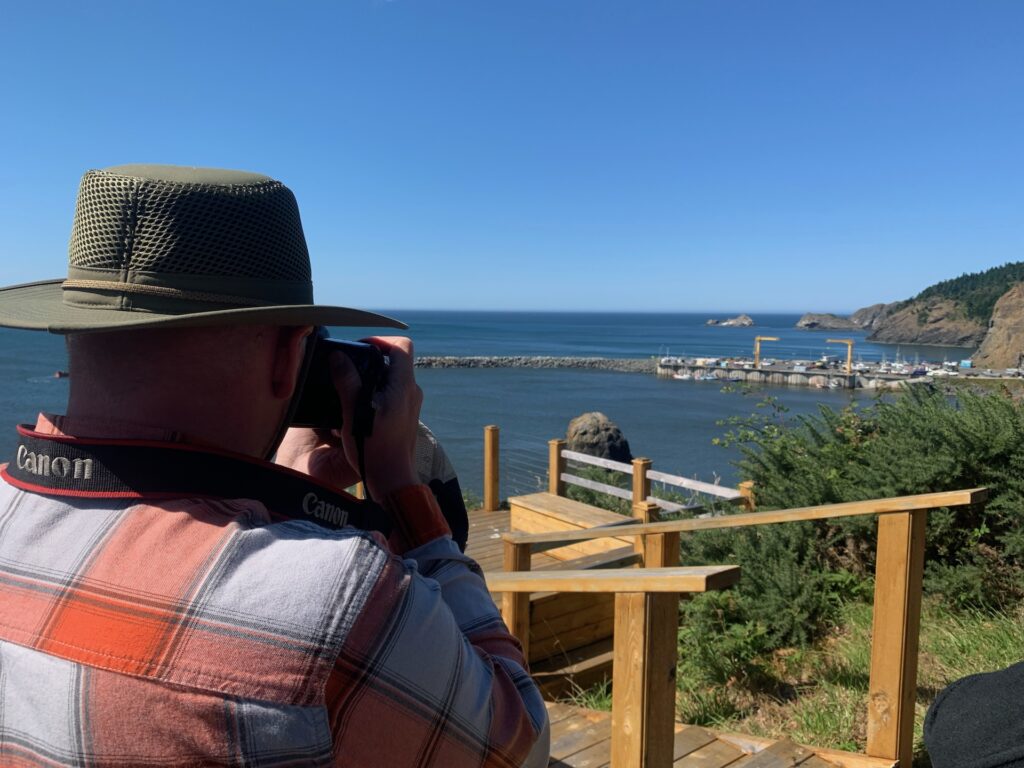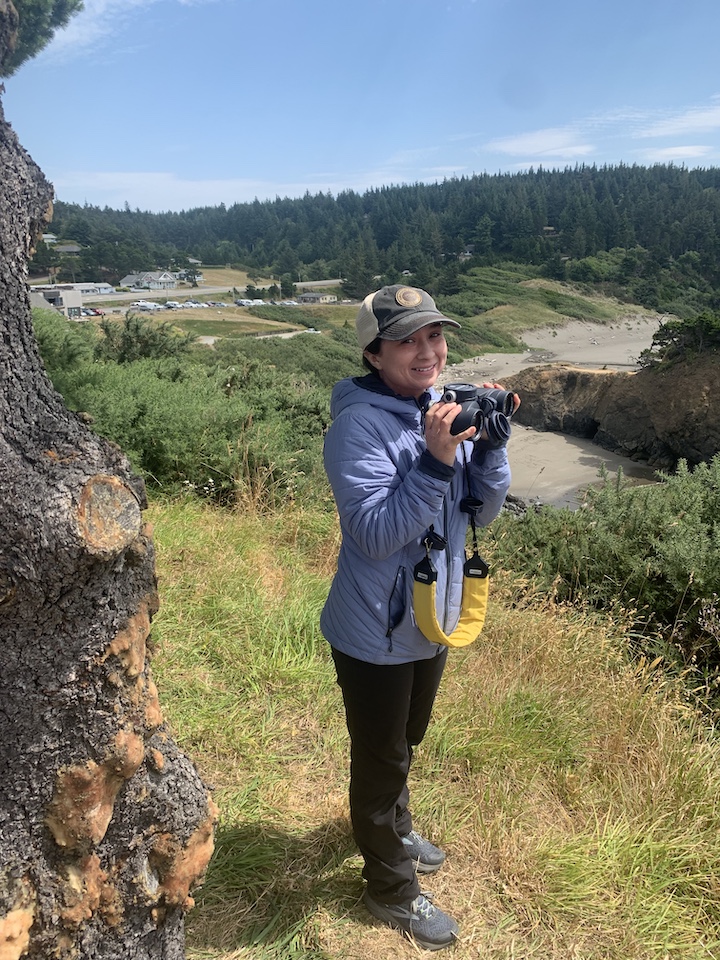By Luke Donaldson, incoming OSU freshman, Department of Forestry, GEMM Lab intern
When I was a toddler, my grandma took me to the Face Rock viewpoint in Bandon, Oregon during summer to look for migrating whales. Even though we never spotted a blow or fluke, it was a great memory, one that helped spark my ever-growing interest in biology and the environment.
As soon as I was old enough, I volunteered to help scientists at the South Slough National Estuarine Research Reserve (SSNERR) work on a variety of research projects, including European green crab (Carcinus maenas) removal in the Coos Estuary. The removal process of the invasive European green crabs from the Coos estuary is similar to current culling efforts of purple sea urchins (Strongylocentrotus purpuratus) by the Oregon Kelp Alliance (ORKA) of here in Port Orford. Both efforts hope to reduce the negative ecological impacts caused by a lack of natural predators on the Oregon coast. Without natural predators, green crabs and sea urchins dominate food sources and reproduce exponentially in their respective ecosystems. In Port Orford, the decline in population of several species of sea stars since 2013 has led to an abundance of sea urchins, an estimated 350 million alone at Orford Reef (Sommer & Kastelnik, 2021). Read Lisa Hildebrand’s blog for more information about how the cycles of potential phase shifts between sea urchins and kelp impact both the ecology and economics along the Oregon coast.
In addition to collecting long term data on gray whale activity and zooplankton abundance, the TOPAZ/JASPER projects have accumulated a yearly inventory of bull kelp canopies in order to record biogeographic changes and monitor areas of concern related to urchin abundance.
After multiple opportunities to hone my skills on the theodolite during our two training weeks, I spent several hours at our cliff observation site helping map kelp beds (read more about the theodolite and its purposes in Nichola’s recent blog). Not only does operating the theodolite require practice and careful precision, but weather also poses a challenge to mapping the surface expression of kelp effectively. Sunlight itself strains the eye and causes a glare in the theodolite objective lens. Wind gusts, tidal changes and swell can all distort kelp patches, so consistent timing is essential. Some areas of Tichenor Cove and Mill Rocks are obstructed by sea stacks, vegetation, and man-made structures, so for these areas we use a Garmin GPS to mark waypoints via kayak to create the perimeter of each kelp patch. With over 1,500 fixes and 120 kelp patches mapped, it was our first formal assessment of kelp this year within our two study areas, Tichenor Cove and Mill Rocks (Figure 1). While kelp cover in Tichenor appears to have increased a little since 2021, the kelp in Mill Rocks shows a great recovery.

Not only is the kelp different between study years and areas, but our zooplankton catches are also showing signs of recovery. The large kelp beds of Mill Rocks support a sustained population of zooplankton, unlike in 2021 or in Tichenor Cove. Last year’s GEMM lab intern Damian Amerman-Smith noted the decline of kelp also appeared to correlate with decreased zooplankton abundance and gray whale foraging activity in Port Orford. However, not only does Mill Rocks yield higher amounts of zooplankton this year, but their average size, especially the mysid Holmesmysis sculpta, appears larger this year than in 2021.
Consequently, this increase in food availability may be the cause of our higher frequency of gray whale observations in Mill Rocks this year. Despite the continued abundance of sea urchins in our study areas, I am optimistic that the current amount of kelp compared to past year’s data might be indicating a recovery of the ecosystem (Figure 2).
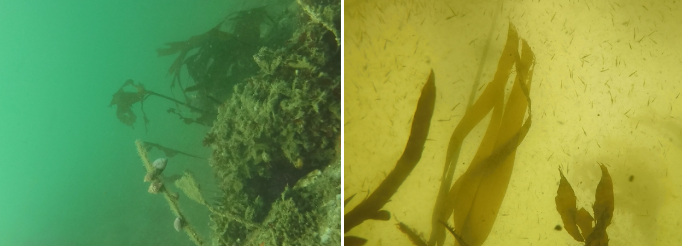
The first gray whale that we observed this year was consistently foraging within the kelp beds of Mill Rocks, which was very encouraging for our team. Through this internship I have learned many interesting things about kelp, including how kelp supplies more than just primary productivity, but also a wide range of services directly and indirectly to gray whales. In addition to being a foundation species of Oregon’s coastal ecosystems, bull kelp specifically provides zooplankton with nutrient-rich detritus, protection from predators, and a buffer from strong ocean currents (Schaffer & Feehan, 2020). Kelp provides gray whales not only with habitat for their prey, but keeps them hygienic as well. Gray whales have been observed “kelping”, where they brush against kelp with their skin like a loofah (Morris, 2016). Although kelping is relatively under-investigated, there are claims that this behavior can double as another foraging method (Busch, 1998). When swimming through kelp, gray whales may scrape off tiny crustaceans clinging to the kelp fronds. It has also been noted that gray whale mothers will hide their calves in kelp to conceal them from predators (Busch, 1998).
Ask anyone who has been to Port Orford and they will attest to the abundance and diversity of marine fauna that thrive in the nutrient-rich coastal waters. I hope this will continue, and that we will see a stable bull kelp canopy kelp ecosystem return here in Port Orford. Stay tuned for more results when the team maps kelp canopies again at the end of August!
Figure 3. Kayak sampling at a large patch of kelp in Mill Rocks. Photo credit: Nichola Gregory
This Gray whale foraging ecology (GWFE) internship has prepared me for college in many ways. Being able to study this dynamic ecosystem is any marine science intern’s dream; and, my decision to pursue Natural Resources as my major has been affirmed through this summer’s field and lab experience. It inspires me to focus on ecology and possibly attend graduate school in the future. The college-like environment of living at the field station has conditioned me for dorm life in the fall; and, the opportunity to meet leading experts in a variety of marine science fields has expanded my knowledge of possible career pathways. With the inspiration and guidance of Dr. Leigh Torres, field station manager Tom Calvanese, team leader Allison Dawn, and the rest of the whale team, I am excited to begin my journey as a natural resource student and future scientist.
Did you enjoy this blog? Want to learn more about marine life, research and conservation? Subscribe to our blog and get weekly updates and more! Just add your name into the subscribe box below!
References
Busch, R. (1998). Gray Whales: Wandering Giants. Orca Book Publishers.
Feehan, C. J., Grauman-Boss, B. C., Strathmann, R. R., Dethier, M. N., & Duggins, D. O. (2017, October 25). Kelp detritus provides high-quality food for sea urchin larvae. Association for the Sciences of Limnology and Oceanography. Retrieved August 13, 2022, from https://aslopubs.onlinelibrary.wiley.com/doi/10.1002/lno.10740
Kastelnik, T. (2021, August 18). Kelp. Oregon Kelp Alliance. Retrieved August 10, 2022, from https://www.oregonkelp.com/
Morris, A. (2016, October 17). We Can’t Kelp But Smile At This Incredible Humpback Footage. Awesome Ocean. Retrieved August 12, 2022, from http://awesomeocean.com/whales/cant-kelp-smile-humpback-whale-footage/
Schaffer, J. A., Munsch, S. H., & Cordell, J. R. (2020, January 21). Kelp Forest Zooplankton, Forage Fishes, and Juvenile Salmonids of the Northeast Pacific Nearshore. American Fisheries Society. Retrieved August 3, 2022, from https://afspubs.onlinelibrary.wiley.com/doi/10.1002/mcf2.10103Sommer, L. (2021, March 31). In Hotter Climate, ‘Zombie’ Urchins Are Winning And Kelp Forests Are Losing. NPR. Retrieved August 3, 2022, from https://www.npr.org/2021/03/31/975800880/in-hotter-climate-zombie-urchins-are-winning-and-kelp-forests-are-losing#:~:text=In%202013%2C%20 sea%20star%20 wasting,Red%20List%20of%20Endangered%20Species.&text=With%20their%20predator%20largely%20gone%2C%20purple%20urchins%20boomed

